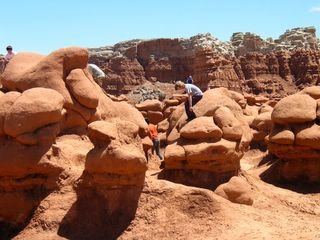
We camped here, about three miles outside of the park. There are spots inside the park with fire rings, running water, even toilets if your into that sort of thing. We elected to rough it, though, and I'm glad we did...the stars were unreal out there away from any light pollution. And the coyotes were loud around us all night.
Goblin Valley is so named for the thousands of sandstone "hoodoos" that haunt the valley floor. They were formed by millions of years of erosion by wind and water. Now only the hardest, most resistent parts of the rock remain. Giving us these wild shapes.

A few of our youth leaders wandering through the hoodoos.

Several Sci-Fi movies have been filmed in Goblin, and for good reason...it feels completely Martian (though I must admit I've never actually been to Mars).

Perhaps you recognize this place from galaxy quest?

It's totally juvenile, I know, but it's awfully hard to beat a game of steal the flag or "Alien" in Goblin Valley. Especially at night.

Goblin Valley State park is one of the coolest places in Southern Utah, and at risk of sounding completely cliche, that's saying something. Unlike most other parks in the region, Goblin is relatively small (scarcely one mile by two miles) and can be fairly easily explored in a single morning or afternoon. You don't have to be in great shape, and you don't need an entire day to enjoy it. Moreover, there are other things to see in the area. The San Raphael Swell and Little Wild Horse Canyon are only minutes down the road. There's also Horshoe Canyon, home to arguably the best ancient rock art in the Southwest, barely a half hour away.
Any tour of Southern Utah's great parks would be incomplete without a diversion to Goblin Valley. Even a very short visit would be worth the detour.
More to come...maybe from horseshoe Canyon?









